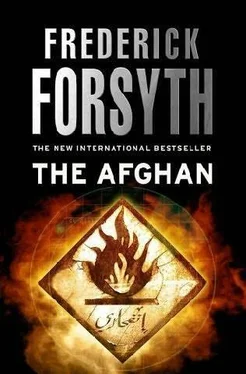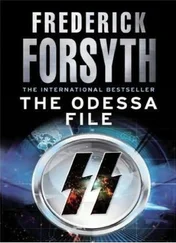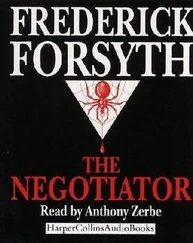The single recording of her captain’s last Mayday message was played to a Norwegian psychiatrist, who confirmed that the voice was a fellow Norwegian speaking good English, but that he seemed to be speaking under duress. The captain of the fruit ship that had noted her given position and diverted to the spot was traced and interviewed. He repeated what he had heard and seen. But experts in fire at sea reckoned that if the fire in the Java Star’s engine room was so catastrophic that Captain Herrmann could not save her, it must have ignited her cargo eventually. In which case, there would be no fabric-tented life rafts left floating on the water where she sank. Filipino commandos carried out a raid, supported by U.S. helicopter gunships, on the Zamboanga peninsula, ostensibly on Abu Sayyaf bases. They trawled, and brought back two jungle-dwelling Huq trackers who occasionally worked for the terrorists but were not prepared to face a firing squad for them. They reported they had seen a medium tanker in a narrow creek in the heart of the jungle being worked on by men with oxyacety-lene torches. The Java Star team entered its report within a year. It declared the Java Star had not been sunk by an onboard fire but had been hijacked intact; and, further, that a lot of trouble had been gone to in order to persuade the marine world that she no longer existed when, in fact, she did. The entire crew was presumed dead already, and this had to be confirmed.
Because of need-to-know, all the arms of the inquiry were working on the various facets without knowing why. They were told-and believed-that it was an insurance investigation.
Another team followed the fortunes of the real Countess of Richmond. They proceeded from the offices of Siebart and Abercrombie in Crutched Friars, City of London, to Liverpool, and checked out the family and crew. They confirmed all was in good order when the Countess unloaded her Jaguars at Singapore. Captain McKendrick had run into a friend from Liverpool on the docks, and they shared a few beers before he sailed. And he telephoned home. Independent witnesses confirmed she was still in the command of her lawful captain when she took on valuable timber at Kinabalu. But an on-the-spot visit to Surabaya, Java, revealed she never even stopped there to take on her second part cargo of Asian silk. Yet Siebart and Abercrombie in London had received confirmation from the shippers that she had. So it was forged. A likeness of “Mr. Lampong” was created, and Indonesian homeland security recognized a suspected but never proven financial supporter of Jemaat Islamiyah. A search was mounted, but the terrorist had vanished into the human tides of Southeast Asia.
The team concluded that the Countess of Richmond had been boarded and hijacked in the Celebes Sea. With all her papers, ID radio codes and transponder stolen, she would have been sunk with all hands. Next of kin were advised.
***
The clincher came from Dr. Ali Aziz al-Khattab The wiretaps on his phones revealed he was booking a departure to the Middle East. After a conference at Thames House, home of MI5, it was decided that enough was enough. The Birmingham police and Special Branch took down the apartment door of the Kuwaiti academic when the listeners confirmed he was in the bath, and he was escorted away in a bathrobe.
But al-Khattab was clever. A total strip search of his apartment, car and office, cell phone and laptop, revealed not one incriminating detail about him. He smiled blandly, and his lawyer protested, through the statutory twenty-eight days allowed to the British police for holding a suspect without preferring a formal charge. His smile faded when, as he stepped out of Her Majesty’s Belmarsh Prison, he was rearrested, this time on an extradition warrant lodged by the government of the United Arab Emirates.
Under this legislation, there is no limit of time. Al-Khattab went straight back to his cell. This time, his lawyer lodged a vigorous appeal against extradition. As a Kuwaiti, al-Khattab was not even a citizen of the UAE, but that wasn’t the point.
The Counterterrorist Center at Dubai had amazingly come into possession of a sheaf of photos. These showed al-Khattab conferring closely with a known Al Qaeda courier, a dhow captain, already under surveillance. Others showed him arriving at, and leaving, a villa in the outback of Ras al-Khaimah, known to be a terrorist hideaway. The London judge was impressed, and granted the extradition.
Al-Khattab appealed… and lost again. Faced with the dubious charms of HMP Belmarsh or an athletic interrogation by UAE Special Forces at their desert base in the Gulf, he asked to stay as a guest of Queen Elizabeth. That posed a problem. The British explained they had nothing to hold him on, let alone try and convict him. He was halfway to Heathrow Airport when he struck his deal and began to talk.
Once started, he caused CIA guests who sat in on the sessions to report back that it was like watching the Boulder Dam give way. He blew away over one hundred AQ agents who until then had been lily-whites, unknown to Anglo-American intelligence, and twenty-four sleeping bank accounts. When the interrogators mentioned the AQ project code-named al-Isra, the Kuwaiti was stunned into silence. He had no idea anyone knew. Then he started to talk again.
He confirmed everything London and Washington already knew or suspected, then added more. He could identify all the eight men aboard the Countess of Richmond on her final voyage, except the three Indonesians. He knew the origins and parentage of the teenager of Pakistani derivation who, born and raised in the English county of Yorkshire, could speak in place of Captain McKendrick on the ship’s radio and fool First Officer David Gundlach. And he admitted the Dona Maria and the men on board her had been a deliberate sacrifice, though unaware of it themselves; a mere diversion lest there be any hesitation, for any reason, in sending the American president to sea on a liner. Gently, the interrogators brought the subject round to an Afghan whom they knew al-Khattab had interrogated in the UAE villa. In fact, they did not know it at all; they suspected it, but al-Khattab hardly hesitated. He confirmed the arrival of the mysterious Taliban commander in Ras al-Khaimah after a daring and bloody escape from custody outside Kabul. He claimed these details had been carefully checked by AQ sympathizers in Kabul and authenticated.
He admitted he had been instructed by Ayman al-Zawahiri himself to go to the Gulf and question the fugitive for as long as it took. And he revealed that it was the sheikh, no less, who had verified the Afghan’s identity on the basis of a conversation years earlier in a hospital cave in the Tora Bora. It was the sheikh who permitted the Afghan the privilege of joining al-Isra, and he, al-Khattab, had dispatched the man to Malaysia with others. It gave his Anglo-American interrogators exquisite pleasure to wreck what was left of his life by telling him who the Afghan really was. In a final detail, a handwriting expert confirmed that the hand of the missing colonel and the person who had scrawled the message thrust into the dive bag at Labuan Island were one and the same.
The Crowbar committee finally agreed that Mike Martin had boarded the Countess of Richmond, still posing as a terrorist, somewhere after Labuan, and that there was not a shred of evidence that he had been able to get off in time. Theories as to why the Countess blew up forty minutes prematurely were left open in the file.
***
It is customary in the UK that seven years are required to elapse before a person missing without trace can be legally presumed dead and a certificate issued.
But when the interrogation of Dr. al-Khattab reached its conclusion, the coroner for the City of Westminster, London, was entertained to a very discreet dinner in a private room at Brooks’s Club, St. James’s Street. There were only three others present, and they explained many things to the coroner once the stewards had left them alone.
Читать дальше










